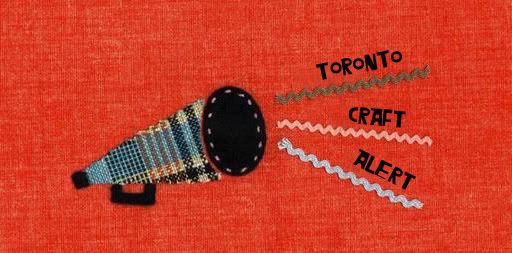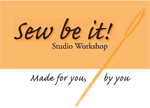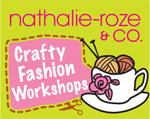CRAFTY CRUSH: bookhou design

bookhou design is a partnership between Toronto-based textile and sculpture artist Arounna Khounnoraj and her husband John Booth, a painter, architect, and furniture maker. After seeing their lovely accessories and stylish home wear celebrated on no less than three American design blogs, I felt it was high time that Toronto Craft Alert get in on the bookhou lovefest. I visited the two and their new baby boy, Lliam in their Distillery District studio to chat about their work and ogle their stuff up close.
Upon entering their cozy studio in the Case Goods Warehouse, it becomes obvious that an impressive diversity of interests is being explored and actualized in John and Arounna’s workspace. Large oil paintings lean against the wall across from a makeshift steam-bending device for John's furniture. Knit pillows nestle linen ones below a rice paper sculpture. Above the screen-printing table, delicate watercolour diagrams are tacked to the wall.

Over time, Arounna has come to believe that one's creative expression shouldn't be restricted a single medium. "I remember when I first started - you're always afraid that 'If you're going to be an artist, you've got to be an Artist', you shouldn't be making all of these other things. But if you're a creative person, you can just do whatever you want, it can go down all these different avenues, in all of these different ways.”
She points to American artist Kiki Smith as an inspiring figure: "What I like about [her] work is that she explores ideas and she's not afraid – she's not stuck in one material – she works with glass, she works with clay, she works with paper, and she does printmaking – she does everything. "
While some of Arounna's sculptural pieces entail esoteric processes such as salt crystallization, many involve craft techniques such as spinning, crocheting, and sewing. She enjoys this kind of handwork immensely. As she puts it: "I love to sew. A lot of my sculptures are all hand sewn and there's something about doing that little busy work that I find so meditative."
In describing her practice Arounna distinguishes between her artwork and her textile work, though she identifies an affinity between these two streams in that all of her work starts out as art first, and then moves in different directions, taking distinct forms. For example, her textile designs begin as, "kind of scribbles and ideas that just become the actual [printed] image." These "tiny tiny little scribbles" are blown up to a much larger size to become "looser and less refined". She sees her sculpture in the same way, where she has "small little ideas that become bigger".
-----8<-----------------------
The word "organic" is frequently used by others in describing Arounna's art and textile pieces. She agrees with this assessment: "I do see my work as organic, and I think even the thoughts and ideas behind it are organic. I think organic means something that isn't so rigid and isn't so mass-produced. I think organic is something a little bit looser in form – the shapes that I use in my sculptures are always sort of referencing things in nature – like sea pods or things that an animal may have created... Also a lot of the materials I use for sculptures... I don't paint them, I don't change them, I kind of just use them and appreciate them for what they are." John agrees that her work is organic on the level of both process and aesthetics, "your work... looks natural, and I think also your work [involves] a natural process, especially in sculpture because it's an organic way of becoming – one step might lead to another, it's not really imposed, you'll actually let it form itself organically."
Arounna has always been reluctant to impose or interfere with with the natural state of materials. Her original background is in ceramics and in school she found it difficult to add glaze to her pieces after they were fired. She explains, "I used to just like making the form and leaving it. And then I would always be told in school, 'It's not finished, you have to glaze it.' So I think when I use materials – like paper or felt or anything, I feel happy with that, because I can use it, I can make the form and then it's done…I like that simplicity".

She points out that a lot of her work is "white-ish" or "off-white" and admits to having a fear of colour, which she feels can act as a distraction from the true form of an object. "That's why I like doing textile work because then the colour of fabric is already there, the decision has already been made, and I can kinda let loose in that area. But even then, a lot of the colours that I use are earth tones, and when I do use red or another bright colour it kind of scares me. Greens and browns make me feel safe."
-----8<-----------------------
“bookhou” is an amalgamation of John and Arounna's last names (Boo[th] + Khou[nnoraj]), which speaks to the collaborative nature of their artistic and interpersonal partnership.

When asked what inspired them to join forces in their art and craft making, John explains, "Well, I guess we get along! Also, we were both in fine art but we were making fine craft things paralleled to art stuff. We were just trying to make sense [of how]…to collaborate together, even if we're not working together. So we collaborate on shows more than we do on the objects, but they tend to go well together, maybe there's ideas that we toss about."
Arounna and John would really like to work towards producing more joint pieces, but are currently overwhelmed with their own respective projects and are excited by future plans for their individual work. In the meantime, it is interesting to observe the mutual influence at play in their work, such as John’s spiral felt trivets, which fit right in with Arounna’s textile work, but are based on one of his steam-bent wood pieces. A similar harmony between their work can be seen in their upcoming show, “Layer upon layer”, where the structural lines of John’s paintings are echoed in Arounna’s wall art. Swing by the opening at *new* gallery this Thursday, August 10th to see for yourselves. 
Layer upon layer
August 9 - 20 2006
*new* gallery906 Queen Street West
Opening reception: Thursday August 10, 6-8 pm
bookhou recommends:
Textile & other artists
Lotta Jansdotter
Marimekko
Kiki Smith
Rachel Whiteread
Anni Albers
Fabric sources
For linen in Toronto: Designer Fabrics (upstairs), and several stores on Queen near Spadina.
Marimekko at The Finnish Place
In San Francisco: Britex
In New York City: Mood Designer Fabric , Marimekko Store
Note: Photos my own and from the bookhou website (see website for more photos of their work). Embroidered bird piece (3rd from bottom) from a collaboration between Arounna and Julie Gibb.






















1 Comments:
ohmygoodness! this stuff is so beautiful and I can't believe this is right here in Toronto. oh I hope I don't forget to go to the gallery.
Post a Comment
<< Home